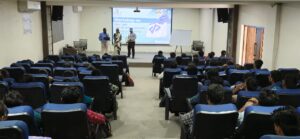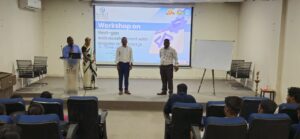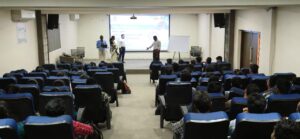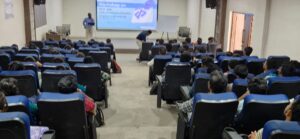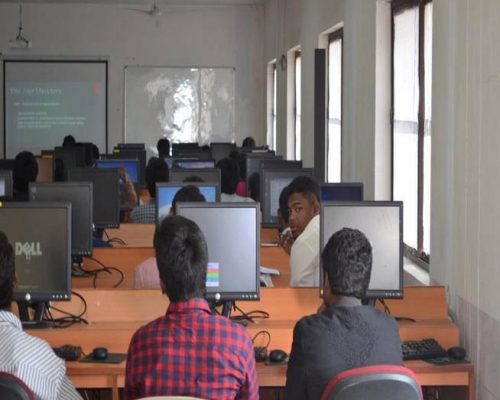CSE - Data Science
KOMMURI PRATAP REDDY INSTITUTE OF TECHNOLOGY
About Department of CSE - Data Science
The Department of Computer Science And Engineering was established in the year 2008. Experienced professors guide the department aiming at educating and training students with sound knowledge and awareness in the fields of Computers, Communication, and Information Technology.
The major goal of the Department of Computer Science And Engineering is to produce highly knowledgeable, competent and resourceful young engineers who can perform well in a wide variety of job profiles. To achieve this, curriculum provides a strong foundation in both the analytic, computing and technological aspects of Computer Science Engineering.
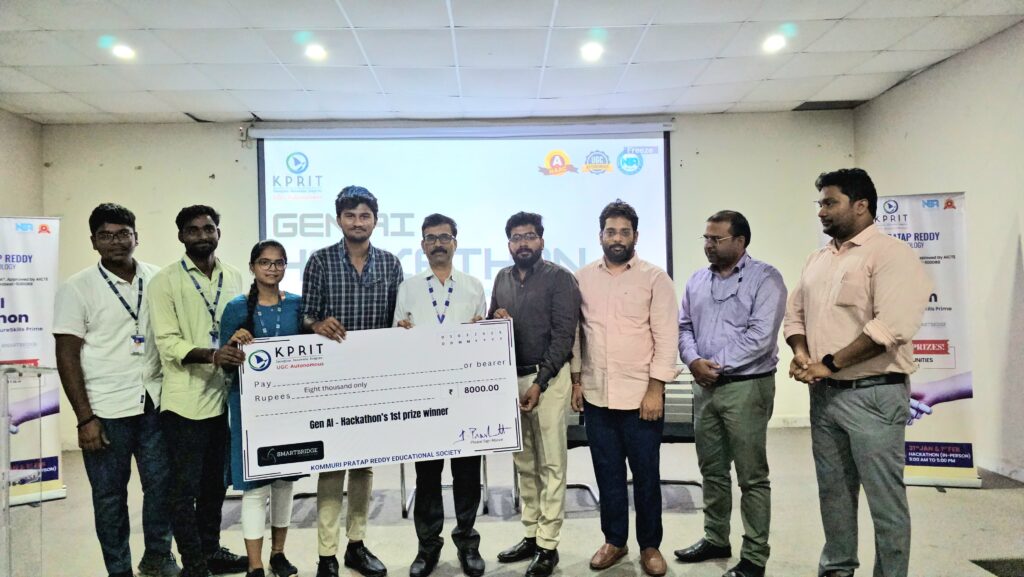
It also provides ample opportunities to students to work on mini-projects, develop communication skills, explore internship opportunities in industry and world-class universities and take part in national and international design contests.
The Department of CSE also organizes Workshops, Expert Talks, Project Expo, Poster Presentation competitions for the students. The department has established the Remote Centre in Supported with IIT Bombay.
Core Companies offering Computer Science And Engineering IMCS group , Madhees Techno Pvt Ltd, Proto Tech Solutions, SIG, ERT Technologies, Multiplier, Stealth Technologies, BYJU’s, Aliens Developers Pvt Ltd.
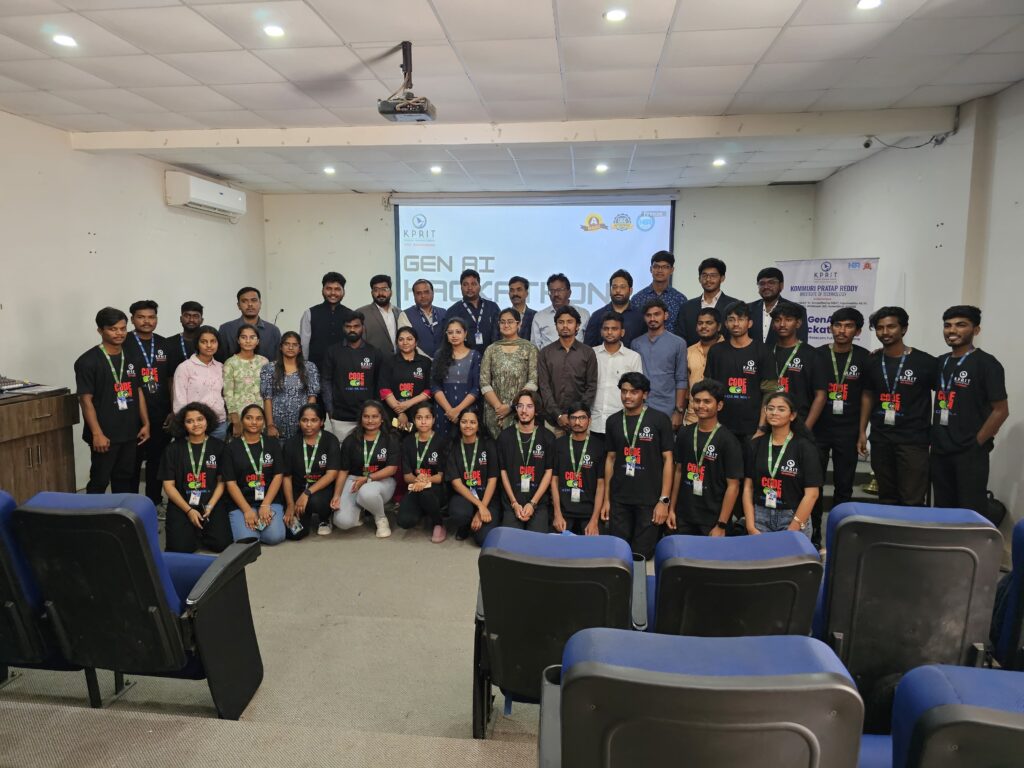
Vision of the Department

To produce excellent standard, quality education of professionals by imparting cognitive learning environment, ethical, research and industrial orientation to become pioneering Data Scientists
Mission of the Department
- Data science is an interdisciplinary field that uses scientific methods, processes, algorithms and systems to extract knowledge by using structured and unstructured data.
- Data science which depend on the application. More recently, full-featured, end-to-end platforms have been developed and heavily used for data science and machine learning.
- To facilitate the programming skills by imparting the qualitative technicality in theoretical and pragmatically approaches.
- Enabling students to get expertise in critical skills with data science education and facilitate socially responsive research and innovation.
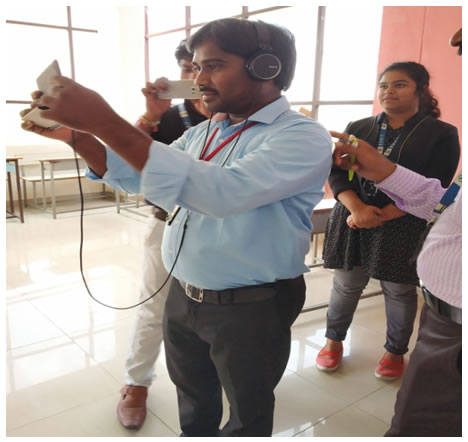
Faculty
S.No | Name of the Staff | Qualification | Designation | JNTU ID | Details |
| 1 | Dr. C Bagath Basha | M.Tech,(PhD) | Professor | 8396-220125-135852 | View |
| 2 | Mr B Ramesh | M.Tech | Asst.Professor | 7510-150413-171731 | View |
| 3 | Ritesh | M.Tech | Asst.Professor | 4868-230413-094207 | View |
| 4 | Niranjani | M.Tech | Asst.Professor | 3273-230401-152123 | View |
| 5 | Vijaya Loda | M.Tech | Asst.Professor | 0025-230123-124543 | View |
| 6 | Ramakrishna | M.Tech | Asst.Professor | 7974-200109-121405 | View |
| 6 | Vijaya Bhaskar Reddy | M.Tech | Asst.Professor | 3713-230401-122201 | View |
Course Outcomes
Course Outcomes are statements that describe significant and essential learning that the Students have achieved, and can reliably demonstrate at the end of a course. A Course outcome makes clear the intended result of the learning rather than what form the instruction will take. A good course outcome states what a student will know or be able to do at the end of instruction. It focuses on student performance. Other synonyms are learning outcome or Course learning outcome.
The advantages of Course Outcomes:
Benefits for the course and module designer
In terms of course and module design, the use of explicit course outcome statements can help ensure consistency of delivery across modules or programs. They can aid curriculum design by clarifying areas of overlap between existing modules, program and qualifications.
Benefits for quality assurance and standards
Quality assurance benefits from the adoption of learning outcomes via the resulting increase in transparency and better comparability of standards between and within qualifications.
Benefits for Students and employers
Students benefit from a comprehensive set of statements of exactly what they will be able to achieve after successful study. Course outcomes provide Students with clear information that can help them with their choice of module/unit/program/qualification to study and can lead to more effective learning.
Benefits for national and international educational transparency
Internationally, Course outcomes contribute to the mobility of students by facilitating the recognition of their qualifications and improving the transparency of qualifications and thus simplifying credit transfer.
Course Outcomes for the Department of Computer Science and Engineering
Industrial visit
| S.no | Name of the industry visited | Date of Visit |
| 1 | L&T Metro | 23-01-2019 |
| 2 | BSNL Regional Telecom Training Centre | 23-07-2018 |
| 3 | BSNL-Regional Telecom Training Centre | 23-1-2018 |
| 4 | Doordarshan Kendra | 11-08-2017 |
| 5 | Doordarshan Kendra, Ramanthapur | 06-09-2016 |
| 6 | T-Hub | 18-02-2017 |
Course file
Course File Contents
Sr. No. | Contents |
1 | Institute V & M , Department V&M, PEO’s, PO’s, PSO’s |
2 | University Syllabus |
3 | Course Outcomes |
4 | CO-PO mapping with Justification |
5 | Is Syllabus Changes Listed? |
6 | Gaps Identified during Mapping if any |
7 | Topics beyond syllabus |
8 | Evidence of (Seminar/ Guest lecture/ Workshop, etc.) conducted for fulfilment of Gap |
9 | Revised CO-PO Mapping if any |
10 | Student Customization based on previous year/ semester result |
11 | Student Customization based on Mid-I & Mid-II |
12 | Course outcome assessment sheet |
13 | Lecture notes |
14 | PPT’s, Videos (in CD), Self Learning Material |
15 | Web references |
16 | Charts |
17 | Assignments |
18 | Tutorial evidence |
19 | Unit wise Question bank |
20 | Is Gate Question bank present? |
21 | Mid 1- Question papers |
22 | Mid 1 – Question paper – Key |
23 | Mid 1 – Question paper – Scheme of Evaluation |
24 | Mid 2- Question papers |
25 | Mid 2 – Question paper – Key |
26 | Mid 2 – Question paper – Scheme of Evaluation |
27 | University Question papers (Last three years) |
28 | Remedial Classes |
29 | Result Analysis (After Completion of course ) |
30 | Student Feedback Analysis |
31 | Lesson plan |
32 | Time table |
33 | Department Calendar |
34 | University Calendar |
35 | Attendance Register -Teacher Log updated with signature of faculty and HOD |
36 | Internal, Assignment Marks entry in Attendance Register |
37 | Sample Answer Sheets |
38 | Sample Assignment Sheets |
39 | Sample Tutorial Sheets |
40 | Audited by IQAC |
Signature of the faculty
KPRIT is implementing OBE. OBE is a student centric teaching-learning methodology in which the course delivery and assessment are planned to achieve the stated objectives and outcomes. To achieve the stated outcomes, the faculty members in the department follows different course delivery methods such as lecturing, tutorials, assignments, remedial classes, quiz, presentations, experimental laboratory work, project work, etc.
ICT Initiatives and Tools
Classrooms Teaching with Audio & Visual Connectivity
The lecture delivered by the faculty is through a set of educational technology/tools such as
- Chalk and Board
- Power point presentation (PPT)
- E-Learning
The faculty use chalk and board and audio-visual aids in teaching. Students are also encouraged to actually interact during the lecture hour by getting the doubts clarified in the same class. The college has sufficient number of computers, printers, LCD projectors, application and system softwares which are used in the teaching process to improve its effectiveness.
The following innovative teaching methods are adopted by the faculty:
- Computing devices with Internet facility are used for teaching processes by the faculty to give Power Point presentations, Role Play, Animations, Videos, Pictures etc., such that the students can easily understand the topic.
- Faculty members are advised to avail the higher learning resources such as NPTEL, Coursera and other credible Internet sources for effective teaching.
- Class rooms with LCD and Internet connection are used for teaching processes.
- The faculty are implementing and utilizing Outcome Based Education (OBE) to cater the learning needs of students through innovative methodologies. Orientation programs are conducted for the newly joined faculty to make them aware of the OBE frame work to practice the regular activities in the department.
- Each faculty prepares lecture notes and after completion of each unit of instruction, the material and soft copy will be shared with students.
- All faculties maintain attendance registers and course files.
- Internal question paper and Assignment Questions are prepared based on Bloom’s taxonomy and Bloom’s score will be calculated to identify the level of difficulty in the questions
Title: Flipped classrooms
Goal: To enhance student higher order learning by reversing the traditional model of a classroom, focusing class time on student understanding rather than on lecture.
Context: Flipped classroom in the Blended learning environment for delivering instructional content is a more advanced solution where face-to-face learning is limited. Students in flipped classes access and watch lecture video, read course handout and come to the classroom to complete activities such as group work, assignments, discussion, projects or other exercises. The flipped classroom model can be seen as a tool for implementation of blended learning.
Practice: Flipped classroom approach in the blended learning environment is extensively used in the department and exploited to its best.
The following are the steps involved in implementation of flipped classroom methodology in our department:
- Concerned course faculty post instructions, lecture material and videos and the students are instructed to go through the same.
- After the completion of each session the students must submit the quiz and grades for each student are issued.
- The students are encouraged to hold discussions over the topic during face-to-face interaction in the classroom with the faculty.
- Faculty members hold virtual class meetings for interaction through meeting application i.e., Google meet. Assignments are disseminated, cam scanned copy of assignment is evaluated and outcome of the assessment is posted for reference.
- After completion of each unit, students are required to submit the assignment for each subject.
Demonstration of Concept:
Demonstration teaching is a model where a teacher or instructor demonstrates a skill, technique, or concept to students, often with the goal of having them replicate or apply what they’ve learned.
- Improved understanding: Students gain a deeper understanding of complex concepts through visual demonstration.
- Increased confidence: Students feel more confident attempting new skills or tasks after observing a demonstration.
- Efficient learning: Demonstration teaching can be an efficient way to teach new skills or concepts.
Best Practices:
- Clear instructions: Provide clear, concise instructions and demonstrations.
- Active observation: Encourage students to actively observe and take notes during the demonstration.
- Practice opportunities: Provide opportunities for students to practice what they’ve learned.
Title: Collaborative Learning
Goal: A collaborative conversation is a purposeful, outcome-driven conversation aimed at building on each others ideas. They generate new thinking and/or a more in-depth understanding of a desired outcome.
Context: The institute is promoting collaborative learning by implementing peer to peer teaching ideology to enhance problem solving capability and team skills which promotes healthy internal relations among the students for their all-round career development.
Peer To Peer Teaching
Peer to peer teaching is an effective teaching technique that can be used in the classroom/ lab to enhance learning. This would enable the students to revise their learning and be able to consolidate to fellow students. It also improves their subject knowledge as well as it improves their confidence with the following benefits:
- Direct interaction between students promotes active learning.
- Peer teachers reinforce their own learning by instructing others.
- Students feel more comfortable and open when interacting with a peer.
- Peers and students share a similar discourse, allowing for greater understanding.
- Teachers get more time to focus on the higher order learning.
Think-Pair-Share (TPS)
TPS technique keeps all the students involved in class discussions and provides an opportunity for every student to share an answer to every question. It takes the fear out of class discussion by allowing the students to think carefully about their answers to talk about them with a partner before they called to respond.
Implementation of Think-Pair-Share Methodology
Monitor and support students as they work through the following:
T: (Think) Teachers initiate the process by asking a specific question. Students “think” about what they know or have learned about the topic.
P: (Pair) Each student shall be paired with another student or a small group.
S: (Share) Students share their thinking with their partner. Teachers expand the “share” into a whole-class discussion.
The following are few more collaborative learning activities that are implemented by the institute. They are as follows:
Seminars
Poster presentations
Paper presentations
Group Discussion
Lecture with Quiz
JAM sessions
Role play:
Role-playing is an effective teaching model that involves students acting out scenarios or roles to learn new skills, concepts, or behaviors.
Steps to Implement Role-Playing:
- Define the scenario: Identify the scenario or topic to be role-played.
- Assign roles: Assign students specific roles to play.
- Set ground rules: Establish rules and expectations for the role-playing activity.
- Debrief and discuss: After the role-playing activity, hold a debriefing session to discuss what was learned.
Best Practices:
- Create a safe environment: Ensure students feel comfortable and safe participating in role-playing activities.
- Encourage participation: Encourage all students to participate and engage in the role-playing activity.
- Provide feedback: Offer constructive feedback to students on their performance and participation.
Animations:
The Animation Teaching model uses animations to convey complex concepts and ideas in an engaging and interactive way.
- Increased engagement: Animations can capture students’ attention and maintain their interest.
- Improved understanding: Animations can help students visualize complex concepts and relationships.
- Enhanced retention: Animations can aid in retaining information and recalling concepts.
Types of Animations:
- 2D animations: Traditional cartoons or computer-generated 2D animations.
- 3D animations: Three-dimensional computer-generated animations.
- Interactive animations: Animations that allow user interaction, such as simulations or games.
Best Practices:
- Clear and concise: Ensure animations are clear, concise, and easy to understand.
- Relevant and engaging: Use animations that are relevant to the topic and engaging for students.
- Integrated with other teaching methods: Use animations in conjunction with other teaching methods, such as lectures and discussions
Title: Self-learning - Celonis Academy, MongoDB, UiPath, QlikLearning, Wadhwani foundation
Goal: The primary goal of engaging in self-learning through Celonis Academy, MongoDB University, UiPath Academy, Qlik Learning, and the Wadhwani Foundation is to build practical, industry-relevant skills that enhance career readiness and personal growth. Develop domain-specific expertise in process mining (Celonis), database management (MongoDB), robotic process automation (UiPath), data analytics (Qlik), and entrepreneurship & soft skills (Wadhwani Foundation).
Context: Self learning using curated courses offered by the mentioned platforms will make the students to learn how to apply theoretical knowledge to real-world scenarios by working on hands-on projects, case studies, and interactive exercises, Cultivate a mindset of continuous learning and adaptability, which are essential for success in the rapidly evolving digital landscape, Improve problem-solving, critical thinking, and automation skills to become more efficient, analytical, and innovation-driven, Earn industry-recognized certifications that strengthen my resume and increase employability in competitive job markets. The interdisciplinary approach by way of offering Minors/Majors in UG-Engineering programs is encouraged by this initiative. The courses on frontiers of engineering/emerging areas, employability skill-oriented courses are offered without compromising on regular curriculum.
Practice: The KPRIT gives information to the students about the courses offered through Training and Placement department. Students are informed to go through the video content and course handout in asynchronous manner. The classroom activities and laboratory sessions are conducted by the concerned mentor who supplements learning and promotes higher order cognition in learning. The synchronous learning instills confidence in the students for taking up regular assignments and submission of the same in timely manner. By completing these self-paced learning programs, the students are strive to become a versatile, tech-savvy, and job-ready professional capable of contributing effectively in dynamic, data-driven work environments.
Title: Experiential Learning
Goal: To promote professional skills and knowledge through hands on experience to increase knowledge and developing skills.
Context: To promote innovation and incubation among the students to become future entrepreneurs. Experiential learning has been initiated through Projects/Lab work and Internships. The motive is to introduce experiential learning to create a platform for the students in such a way that they get direct experience and exposure of work place setting, which in turn leads to all round development of the students under the guidelines of experienced teachers and resource persons in the respective domain
Practice: Project Method
This method is used to improve the ability to apply and to reinforce knowledge imparted in the classroom. Being a technical Institute, this method is extensively used to provide empirical evidence of the theory which is learned in the classroom. This will help the students to understand and apply concepts, principles or laws learned. The faculty and experts from industry guides the students at various stages of developing the projects to give timely inputs for the development of the model.
Major steps of the Project Method
- Creating the situation (providing a situation)
- Choosing the project (Selection of the Project)
- Planning.
- Carrying out the project (Executing)
- Evaluating
- Project Report
Best projects for the Academic Year 2020-21
Department | Project No. | Title of Project | Roll No. | Name of Student | Name of Guide |
Computer Science & Engineering | Project 1 | Securing Data With Block Chain Technology | 17RA1A0520 | A Pavithra | Dr.C.Veena |
17RA1A0509 | Thatikonda Dinesh | ||||
17RA1A0502 | GopagoniAmisha | ||||
Project 2 | Deep Learning Convolution Neural Networks For Pneumonia Detection Using Lung Images | 17RA1A0537 | G.SaikamalTeja | Ch.Shailaja | |
17RA1A0514 | G.Mahesh | ||||
17RA1A0527 | P.SairamRedddy |
Internal Quality of Question Paper
A sample of mid semester question paper is specified below.
Academic Year: 2017-18

Scheme for Weak and Advanced Learners
The department has a well defined process of monitoring, guiding and assisting the students and to identify them as weak or bright students and providing them necessary support in improving their performance.
Process of identification of students as weak/ bright students:
- Appropriate care has taken by the faculty in monitoring the performance of a student in the class, attendance, assignment, mid semester and external examination results.
- The mentors regularly conduct meeting with the students and identify weak and bright students.
- The mentors regularly conduct meeting with the students and identify weak and bright students.
- Faculty will analyze and identify the weak students and bright students based on their previous performance before the start of the semester.
- After the 3rd week of classes based on the observation and previous semester result the identification of weak and bright students will be done.
Scheme
Students who got below 60% or less than or equal to 14/25 marks in mid semester are considered as weak students, Students who scored above 72 % or more than 18/25 Marks are considered as bright students.
Contact Us

Mr. B.Ramesh
HoD-DS




